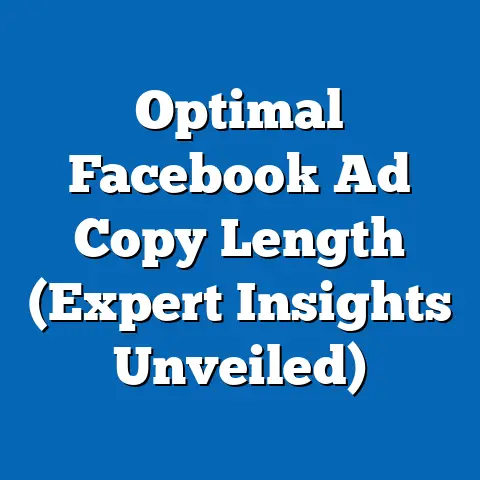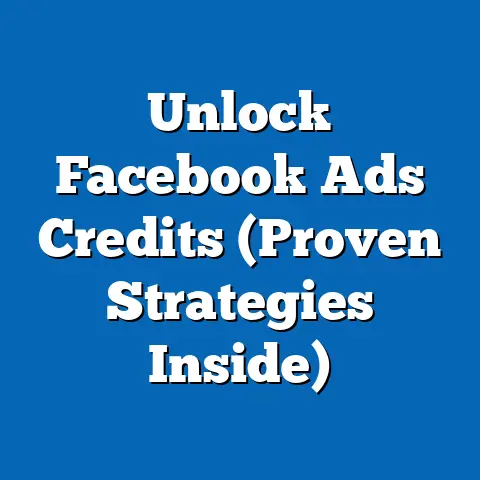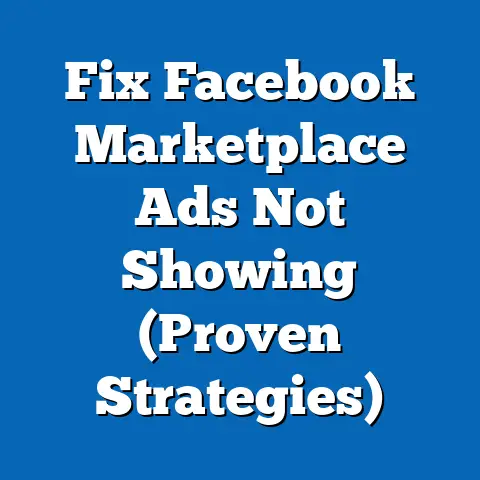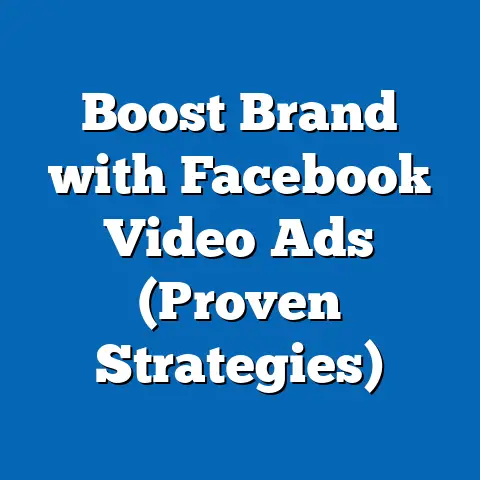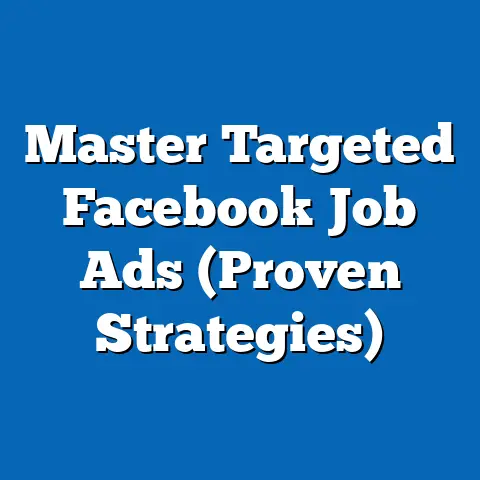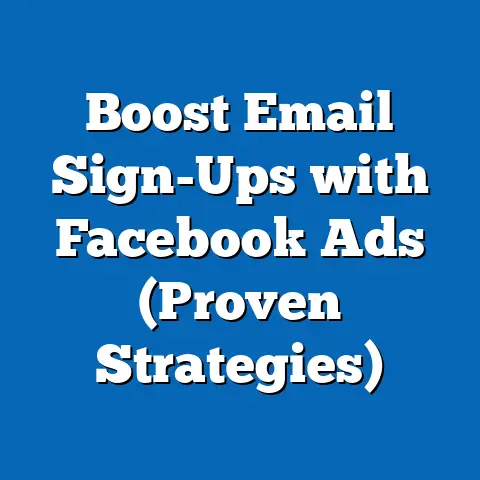Maximize Facebook Ads with Powerful Apps (Game-Changing Tools)
Imagine your Facebook ad campaigns as a vibrant, flourishing garden. You’ve got the seeds of great ideas, the soil of your target audience, and the sunshine of a compelling offer. But to truly unlock its potential and see it blossom into something extraordinary, you need the right tools. Just like a skilled gardener relies on specialized equipment to cultivate the soil, plant seeds, and nurture growth, advertisers must leverage innovative applications to enhance their Facebook ad campaigns and achieve remarkable results.
Over the years, I’ve seen countless businesses struggle to get the most out of their Facebook ad spend. They pour money in, hoping for a bountiful harvest, but often end up with lackluster results. The problem isn’t always the seeds or the soil, but rather the lack of the right tools to cultivate them effectively.
Understanding the Landscape of Facebook Advertising
Facebook advertising has evolved from a simple platform for promoting your business to a sophisticated ecosystem with immense potential. With billions of active users, Facebook offers unparalleled reach and targeting capabilities, making it an essential tool for digital marketers worldwide.
The Power of Facebook Ads:
- Reach: Facebook boasts over 2.9 billion monthly active users, offering a vast audience for your ads.
- Targeting: Granular targeting options allow you to reach specific demographics, interests, behaviors, and even custom audiences based on your existing customer data.
- Variety: Facebook offers a range of ad formats, including image ads, video ads, carousel ads, and more, allowing you to tailor your message to different audiences and objectives.
- Measurable Results: Facebook provides robust analytics and reporting tools, allowing you to track your campaign performance and make data-driven optimizations.
Recent Trends in Facebook Advertising:
- Video Dominance: Video ads are increasingly popular and effective, capturing attention and driving engagement.
- Mobile-First Approach: With the majority of Facebook users accessing the platform on mobile devices, optimizing your ads for mobile is crucial.
- Personalization: Consumers expect personalized experiences, and Facebook’s targeting capabilities allow you to deliver relevant ads to individual users.
- Increased Competition: The Facebook advertising landscape is becoming increasingly competitive, requiring advertisers to be more strategic and creative.
Challenges in Facebook Advertising:
- Rising Costs: As more businesses flock to Facebook advertising, ad costs are rising, making it essential to optimize your campaigns for efficiency.
- Algorithm Changes: Facebook’s algorithm is constantly evolving, requiring advertisers to stay up-to-date and adapt their strategies accordingly.
- Ad Fatigue: Users can become desensitized to ads over time, requiring advertisers to refresh their creatives and targeting to maintain engagement.
- Data Privacy: Growing concerns about data privacy are leading to stricter regulations, requiring advertisers to be transparent and responsible with user data.
Key Takeaway: Facebook advertising offers immense potential but also presents challenges. To succeed in this competitive landscape, you need to leverage the right tools and strategies.
The Role of Apps in Facebook Advertising
In the ever-evolving world of Facebook advertising, simply creating an ad and hoping for the best is no longer enough. To truly stand out and achieve remarkable results, you need to leverage the power of apps. These tools act as force multipliers, streamlining your operations, enhancing your creativity, and optimizing your advertising efforts.
Think of apps as the specialized tools in a carpenter’s workshop. A hammer is useful, but a power saw, a precision level, and a specialized joinery tool allow the carpenter to create something truly exceptional. Similarly, apps provide advertisers with the capabilities to:
- Streamline Operations: Automate repetitive tasks, saving time and resources.
- Enhance Creativity: Access professional design tools and templates to create eye-catching ad creatives.
- Optimize Targeting: Identify and reach the right audience with laser-like precision.
- Improve Reporting: Gain deeper insights into your campaign performance and identify areas for improvement.
- Boost ROI: Maximize your return on investment by optimizing your campaigns for efficiency and effectiveness.
Integration is Key:
The true power of apps lies in their integration with the Facebook advertising platform. Seamless integration allows you to:
- Import Data: Easily import data from your CRM, website, and other sources to create custom audiences.
- Track Conversions: Accurately track conversions and attribute them to specific ad campaigns.
- Automate Tasks: Automate tasks such as ad creation, bidding, and reporting.
- Optimize in Real-Time: Make data-driven optimizations to your campaigns in real-time.
My Experience: I remember when I first started using Facebook ads. I was spending hours manually creating ads, tracking performance in spreadsheets, and trying to figure out what was working and what wasn’t. It was a tedious and time-consuming process. Then, I discovered the power of apps. By integrating tools like AdEspresso and Canva into my workflow, I was able to automate many of the repetitive tasks, create more engaging ad creatives, and optimize my campaigns for better results. The difference was night and day!
Key Takeaway: Apps are essential tools for maximizing your Facebook advertising efforts. They streamline operations, enhance creativity, optimize targeting, improve reporting, and boost ROI. Seamless integration with the Facebook platform is key to unlocking their full potential.
Game-Changing Tools to Maximize Facebook Ads
Now, let’s dive into the exciting world of apps and explore some of the game-changing tools that can transform your Facebook advertising results. I’ve categorized these tools by their primary function to help you find the right solutions for your specific needs.
Ad Creation Tools
1. Canva:
- Description: Canva is a user-friendly graphic design platform that offers a wide range of templates, images, and design elements to create professional-looking ads.
- Features: Drag-and-drop interface, customizable templates, vast library of images and graphics, team collaboration features.
- Benefits: Easy to use, affordable, and provides everything you need to create high-quality ad creatives.
- My Experience: I’ve used Canva extensively for creating Facebook ads. The pre-designed templates save me a ton of time, and the drag-and-drop interface makes it easy to customize them to match my brand. I especially love the ability to collaborate with my team on designs.
- Example: Create a visually appealing image ad for a clothing store using Canva’s templates and stock photos. Customize the text and colors to match the brand’s identity.
- Pricing: Free plan available, with paid plans starting at \$12.99 per month.
2. Adobe Spark:
- Description: Adobe Spark is a powerful graphic design tool that allows you to create stunning visuals, videos, and web pages.
- Features: Wide range of templates, customizable fonts and colors, animation features, integration with other Adobe products.
- Benefits: Professional-quality designs, advanced features, and seamless integration with other Adobe tools.
- My Experience: I’ve found Adobe Spark to be particularly useful for creating animated ads and video ads. The animation features are easy to use, and the integration with Adobe Creative Cloud allows me to leverage my existing design assets.
- Example: Create an animated video ad for a software company using Adobe Spark’s animation features and templates. Add music and voiceover to make the ad more engaging.
- Pricing: Free plan available, with paid plans starting at \$9.99 per month.
Key Takeaway: Canva and Adobe Spark are excellent ad creation tools that provide you with the resources and features to design visually appealing and engaging Facebook ads.
Analytics and Reporting Tools
Data is the lifeblood of successful Facebook advertising. These tools provide you with the insights you need to understand your campaign performance, identify areas for improvement, and make data-driven decisions.
1. Facebook Analytics (Meta Business Suite Analytics):
- Description: Facebook Analytics (now integrated into Meta Business Suite Analytics) is a built-in tool that provides comprehensive data on your Facebook ad performance.
- Features: Key metrics such as reach, impressions, clicks, conversions, and cost per result, audience demographics, and custom reports.
- Benefits: Free to use, provides detailed insights into your Facebook ad performance, and allows you to track your progress over time.
- My Experience: I rely heavily on Facebook Analytics to track my campaign performance. I use it to identify my top-performing ads, understand my audience demographics, and optimize my campaigns for better results.
- Example: Track the number of leads generated by a Facebook ad campaign using Facebook Analytics. Analyze the demographics of the leads to understand which audience segments are most responsive.
- Pricing: Free.
2. Google Analytics:
- Description: Google Analytics is a web analytics platform that provides insights into your website traffic and user behavior.
- Features: Track website traffic, user demographics, conversion rates, and campaign performance.
- Benefits: Free to use, provides valuable insights into your website traffic, and allows you to track the impact of your Facebook ads on your website.
- My Experience: I use Google Analytics to track the traffic generated by my Facebook ads and to understand how users are interacting with my website after clicking on my ads. This helps me to optimize my landing pages and improve my conversion rates.
- Example: Track the number of website visitors generated by a Facebook ad campaign using Google Analytics. Analyze the bounce rate and time on site to understand how engaging the landing page is.
- Pricing: Free plan available, with paid plans starting at \$150 per month.
3. Sprout Social:
- Description: Sprout Social is a social media management platform that provides comprehensive analytics and reporting features.
- Features: Track social media engagement, audience demographics, and campaign performance, social listening, and team collaboration features.
- Benefits: Provides a comprehensive view of your social media performance, allows you to track your progress over time, and facilitates team collaboration.
- My Experience: I use Sprout Social to track my social media engagement and to understand how my Facebook ads are contributing to my overall social media performance. I also use it to monitor brand mentions and to respond to customer inquiries.
- Example: Track the number of social media shares and comments generated by a Facebook ad campaign using Sprout Social. Analyze the sentiment of the comments to understand how users are reacting to the ad.
- Pricing: Plans starting at \$99 per user per month.
Key Takeaway: Facebook Analytics, Google Analytics, and Sprout Social are powerful analytics and reporting tools that provide you with the insights you need to understand your campaign performance and make data-driven decisions.
A/B Testing and Optimization Tools
A/B testing is the process of comparing two versions of an ad to see which one performs better. These tools make it easy to run A/B tests and optimize your campaigns for maximum performance.
1. AdEspresso:
- Description: AdEspresso is a Facebook ad management platform that provides powerful A/B testing and optimization features.
- Features: Automated A/B testing, ad optimization recommendations, and reporting features.
- Benefits: Makes it easy to run A/B tests, provides actionable insights, and helps you to optimize your campaigns for better results.
- My Experience: I’ve used AdEspresso to run A/B tests on my Facebook ads for years. The automated A/B testing feature saves me a ton of time, and the ad optimization recommendations help me to improve my campaign performance.
- Example: A/B test different headlines and images for a Facebook ad to see which combination generates the most clicks.
- Pricing: Plans starting at \$69 per month.
2. Optimizely:
- Description: Optimizely is a website optimization platform that allows you to run A/B tests on your landing pages and website content.
- Features: A/B testing, personalization, and multivariate testing.
- Benefits: Helps you to optimize your landing pages and website content for better conversion rates.
- My Experience: I use Optimizely to run A/B tests on my landing pages to see which variations generate the most leads and sales. The personalization features allow me to tailor the landing page experience to individual users, which has significantly improved my conversion rates.
- Example: A/B test different headlines and calls to action on a landing page to see which combination generates the most leads.
- Pricing: Contact Optimizely for pricing information.
Key Takeaway: AdEspresso and Optimizely are excellent A/B testing and optimization tools that help you to refine your targeting, ad creatives, and landing pages for maximum performance.
Audience Targeting Tools
Reaching the right audience is crucial for the success of any Facebook ad campaign. These tools help you to identify and target your ideal customers with laser-like precision.
1. Facebook Audience Insights (Meta Audience Insights):
- Description: Facebook Audience Insights (now Meta Audience Insights) is a tool that provides insights into the demographics, interests, and behaviors of your target audience.
- Features: Audience demographics, interests, behaviors, and page likes.
- Benefits: Helps you to understand your target audience better and to create more effective ad campaigns.
- My Experience: I use Facebook Audience Insights to research my target audience before launching a new campaign. This helps me to identify the interests and behaviors that are most relevant to my target audience, which allows me to create more targeted and effective ads.
- Example: Research the interests and behaviors of people who are interested in fitness and healthy living using Facebook Audience Insights.
- Pricing: Free.
2. Lookalike Audiences:
- Description: Lookalike Audiences is a Facebook feature that allows you to create audiences that are similar to your existing customers or website visitors.
- Features: Create audiences that are similar to your existing customers, website visitors, or email subscribers.
- Benefits: Helps you to reach new customers who are likely to be interested in your products or services.
- My Experience: I’ve had great success using Lookalike Audiences to reach new customers. By creating audiences that are similar to my existing customers, I’ve been able to significantly increase my reach and generate more leads and sales.
- Example: Create a Lookalike Audience based on your existing customer list to reach new customers who are similar to your best customers.
- Pricing: Free.
Key Takeaway: Facebook Audience Insights and Lookalike Audiences are powerful audience targeting tools that help you to identify and reach your ideal customers with laser-like precision.
Automation Tools
Managing Facebook ad campaigns can be time-consuming, especially if you’re running multiple campaigns. These automation tools help you to streamline your operations, save time, and increase productivity.
1. Zapier:
- Description: Zapier is an automation platform that allows you to connect different apps and automate tasks.
- Features: Connect different apps, automate tasks, and create custom workflows.
- Benefits: Saves you time and effort by automating repetitive tasks.
- My Experience: I use Zapier to automate a variety of tasks related to my Facebook ad campaigns, such as adding new leads to my CRM and sending email notifications when a new lead is generated. This saves me a ton of time and allows me to focus on more strategic tasks.
- Example: Automatically add new leads generated by a Facebook ad campaign to your CRM using Zapier.
- Pricing: Free plan available, with paid plans starting at \$19.99 per month.
2. Hootsuite:
- Description: Hootsuite is a social media management platform that allows you to schedule posts, manage your social media accounts, and track your social media performance.
- Features: Schedule posts, manage social media accounts, track social media performance, and team collaboration features.
- Benefits: Saves you time and effort by automating your social media tasks.
- My Experience: I use Hootsuite to schedule my Facebook posts and to track my social media performance. The team collaboration features allow me to easily collaborate with my team on social media marketing efforts.
- Example: Schedule your Facebook posts for the week using Hootsuite.
- Pricing: Plans starting at \$49 per month.
Key Takeaway: Zapier and Hootsuite are excellent automation tools that help you to streamline your operations, save time, and increase productivity in managing your Facebook ad campaigns.
Case Studies: Success Stories Using Powerful Apps
To illustrate the power of these apps, let’s take a look at some real-world case studies of businesses that have successfully maximized their Facebook ads using specific tools.
Case Study 1: Clothing Store Using Canva and Facebook Analytics
- Challenge: A local clothing store struggled to create visually appealing Facebook ads that captured the attention of their target audience.
- Solution: The store began using Canva to create professional-looking image ads with customizable templates and high-quality stock photos. They also used Facebook Analytics to track the performance of their ads and identify which creatives were generating the most clicks and conversions.
- Results: The store saw a 30% increase in click-through rates and a 20% increase in sales after implementing Canva and Facebook Analytics.
- Lessons Learned: High-quality ad creatives are essential for capturing attention and driving conversions. Tracking your ad performance and making data-driven optimizations is crucial for maximizing your ROI.
Case Study 2: Software Company Using AdEspresso and Optimizely
- Challenge: A software company struggled to improve the conversion rates of their Facebook ad campaigns.
- Solution: The company began using AdEspresso to run A/B tests on their ad creatives and targeting. They also used Optimizely to run A/B tests on their landing pages.
- Results: The company saw a 50% increase in conversion rates after implementing AdEspresso and Optimizely.
- Lessons Learned: A/B testing is a powerful tool for optimizing your ad creatives and landing pages. Continuously testing and refining your campaigns is crucial for maximizing your conversion rates.
Case Study 3: E-commerce Business Using Lookalike Audiences and Zapier
- Challenge: An e-commerce business struggled to reach new customers who were likely to be interested in their products.
- Solution: The business began using Lookalike Audiences to create audiences that were similar to their existing customers. They also used Zapier to automate the process of adding new leads to their CRM.
- Results: The business saw a 40% increase in sales after implementing Lookalike Audiences and Zapier.
- Lessons Learned: Lookalike Audiences are a powerful tool for reaching new customers who are likely to be interested in your products or services. Automation can save you time and effort and allow you to focus on more strategic tasks.
Key Takeaway: These case studies demonstrate the power of apps to transform your Facebook advertising results. By leveraging the right tools and strategies, you can achieve remarkable success.
Integrating Apps into Your Facebook Ad Strategy
Now that you’re familiar with some of the game-changing apps available, let’s discuss how to integrate them into your Facebook ad strategy. Here’s a step-by-step guide:
Step 1: Identify Your Needs:
- What are your biggest challenges in Facebook advertising?
- What areas do you want to improve?
- What are your goals for your Facebook ad campaigns?
Step 2: Research and Select Apps:
- Based on your needs, research different apps that can help you to achieve your goals.
- Read reviews and compare features and pricing.
- Choose the apps that are the best fit for your specific needs and budget.
Step 3: Integrate Apps with Facebook:
- Follow the instructions provided by the app to integrate it with your Facebook ad account.
- Make sure the integration is seamless and that data is flowing correctly between the app and Facebook.
Step 4: Test and Optimize:
- Experiment with different features and settings in the app.
- Track your campaign performance and make data-driven optimizations.
- Continuously test and refine your strategy to maximize your ROI.
My Recommendations:
- Start with a few key apps that address your biggest challenges.
- Don’t try to implement too many apps at once.
- Focus on mastering the apps that you choose and integrating them seamlessly into your workflow.
Key Takeaway: Integrating apps into your Facebook ad strategy can be a game-changer. By following these steps, you can leverage the power of apps to achieve remarkable results.
Future Trends in Facebook Advertising and Apps
The world of Facebook advertising is constantly evolving, and the role of apps will continue to grow in importance. Here are some future trends to watch out for:
- Artificial Intelligence (AI): AI-powered apps will play an increasingly important role in automating and optimizing Facebook ad campaigns. AI can be used to predict which ads will perform best, to personalize ad creatives for individual users, and to optimize bidding strategies in real-time.
- Machine Learning: Machine learning algorithms will be used to analyze vast amounts of data and identify patterns that can be used to improve campaign performance. Machine learning can be used to predict which audiences are most likely to convert, to identify the optimal time to show ads, and to personalize ad creatives based on user behavior.
- Augmented Reality (AR): AR apps will allow advertisers to create immersive and engaging ad experiences. AR ads can be used to allow users to try on clothes virtually, to see how furniture would look in their homes, or to explore different destinations.
- Personalization: Consumers expect personalized experiences, and apps will play an increasingly important role in delivering personalized ads. Apps can be used to collect data on user preferences and behaviors and to create personalized ad creatives that are tailored to individual users.
My Prediction: In the future, Facebook advertising will be even more data-driven and automated. Apps will be essential tools for managing and optimizing campaigns, and advertisers who embrace these tools will be the most successful.
Key Takeaway: The future of Facebook advertising is data-driven and automated. Apps will play an increasingly important role in managing and optimizing campaigns, and advertisers who embrace these tools will be the most successful.
Conclusion
Just like a skilled gardener relies on specialized tools to cultivate their garden and reap a bountiful harvest, advertisers must leverage innovative applications to enhance their Facebook ad campaigns and achieve remarkable results.
Throughout this article, I’ve explored the landscape of Facebook advertising, highlighted the crucial role apps play in optimizing your efforts, and introduced you to a selection of powerful tools that can transform your results.
Remember, the key to success is to identify your needs, research and select the right apps, integrate them seamlessly into your workflow, and continuously test and optimize your strategy.
By embracing the power of apps, you can unlock the full potential of your Facebook ad campaigns and achieve your marketing goals. So, go forth and cultivate your advertising garden with the right tools, and watch your business flourish!

